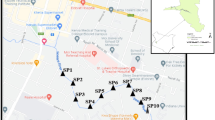Abstract
Selected pharmaceuticals including antibiotics, antipyretics, a stimulant, an antiepileptic and an antipsychotic drug were determined in wastewater, surface water and sediment along the Umgeni River which is the main source of water to Durban City in KwaZulu-Natal, South Africa. Samples were analysed using high-performance liquid chromatography coupled to a mass spectrometer (HPLC-MS/MS) after clean up and pre-concentration by solid phase extraction (SPE). At the wastewater treatment plant outlet, the antipyretic ibuprofen was detected in concentrations up to 12.94 μg/L and 15.96 ng/g in wastewater and bio-solids, respectively. The antipsychotic clozapine was detected in concentrations up to 14.43 μg/L and 18.75 ng/g in wastewater and bio-solids, respectively. Other pharmaceuticals namely sulfamethazine, sulfamethoxazole, erythromycin, metronidazole, trimethoprim, acetaminophen, caffeine and carbamazepine were also detected but in lower concentration compared to clozapine and ibuprofen (<10 μg/L or 10 ng/g). Clozapine and ibuprofen were detected at high concentrations in the surface water and sediment of Umgeni River. The highest concentration of clozapine (78.33 μg/L) was detected at the business park, while that for ibuprofen (62.0 μg/L) was detected at the point where a tributary, Msunduzi, joins Umgeni. Metronidazole was only detected in sediment, and caffeine (2243.52 ng/g) was detected at the highest concentration in the sediment at the blue lagoon sampling site. The antibiotic sulfamethoxazole was also detected in appreciable amounts up to 507.34 ng/g in the sediment at the Msunduzi tributary sampling site. The data collected implies that while insufficiently treated wastewater contributes to surface water contamination, human activities also contribute appreciably to the pharmaceutical loading of River Umgeni.





Similar content being viewed by others
References
Amdany R (2012), Passive samplers: development and application in monitoring organic micropollutants in South African Water Bodies and Wastewater in chemistry, Witwatersrand University
Babić S, Ašperger D, Mutavdžić D, Horvat AJM, Kaštelan-Macan M (2006) Solid phase extraction and HPLC determination of veterinary pharmaceuticals in wastewater. Talanta 70(4):732–738
Camacho-Muñoz D, Martín J, Santos JL, Aparicio I, Alonso E (2014) Concentration evolution of pharmaceutically active compounds in raw urban and industrial wastewater. Chemosphere 111:70–79
Clara M, Strenn B, Kreuzinger N (2004) Carbamazepine as a possible anthropogenic marker in the aquatic environment: investigations on the behaviour of Carbamazepine in wastewater treatment and during groundwater infiltration. Water Res 38(4):947–954
Deblonde T, Cossu-Leguille C, Hartemann P (2011) Emerging pollutants in wastewater: a review of the literature. Int J Hyg Environ Health 214(6):442–448
Dehghani MH, Khaniki GRJ, Mohammadi H, Nasseri S, Mahvi AH, Younessian M, Mazlomi S (2011) Microbiological quality of drinking water in Shadegan Township, Iran. World Appl Sci J 13(1):114–118
Fatta-Kassinos D, Meric S, Nikolaou A (2011) Pharmaceutical residues in environmental waters and wastewater: current state of knowledge and future research. Anal Bioanal Chem 399(1):251–275
Gros M, Petrović M, Ginebreda A, Barceló D (2010) Removal of pharmaceuticals during wastewater treatment and environmental risk assessment using hazard indexes. Environ Int 36(1):15–26
Hilscherova K, Kannan K, Nakata H, Hanari N, Yamashita N, Bradley PW, McCabe JM, Taylor AB, Giesy JP (2003) Polychlorinated dibenzo-p-dioxin and dibenzofuran concentration profiles in sediments and flood-plain soils of the Tittabawassee River, Michigan. Environ Sci Technol 37(3):468–474
Hirsch Roman TT, Klaus H, Armin M, Frank B, Karl-Ludwig K (1998) Determination of antibiotics in different water compartments via liquid chromatography–electrospray tandem mass spectrometry. J Chromatogr A 815(2):213–223
ImpactRx About Us.http://www.impactrx.co.za/about-us retrieved on the 17/05/2014, 2014.
K’Oreje KO, Demeestere K, De Wispelaere P, Vergeynst L, Dewulf J, Van Langenhove H (2012) From multi-residue screening to target analysis of pharmaceuticals in water: development of a new approach based on magnetic sector mass spectrometry and application in the Nairobi River basin, Kenya. Sci Total Environ 15(437):153–164
Kümmerer K (2009) The presence of pharmaceuticals in the environment due to human use—present knowledge and future challenges. J Environ Manag 90(8):2354–2366
Kümmerer K (2010) Pharmaceuticals in the environment. Annu Rev Environ Resour 35:57–75
Lee HB, Peart TE, Svoboda ML (2005) Determination of endocrine-disrupting phenols, acidic pharmaceuticals, and personal-care products in sewage by solid-phase extraction and gas chromatography–mass spectrometry. J Chromatogr A 1094(1):122–129
Li Y, Jindal R, Choi K, Kho YL, de Bullen PG (2010) Pharmaceutical residues in wastewater treatment plants and surface waters in Bangkok. J Hazard Toxic Radioact Waste 16(1):88–91
Löffler D, Ternes TA (2003) Determination of acidic pharmaceuticals, antibiotics and ivermectin in river sediment using liquid chromatography–tandem mass spectrometry. J Chromatogr A 1021(1):133–144
Mohapatra D, Brar S, Tyagi R, Picard P, Surampalli R (2012) Carbamazepine in municipal wastewater and wastewater sludge: ultrafast quantification by laser diode thermal desorption-atmospheric pressure chemical ionization coupled with tandem mass spectrometry. Talanta 99:247–255
Okuda T, Yamashita N, Tanaka H, Matsukawa H, Tanabe K (2009) Development of extraction method of pharmaceuticals and their occurrences found in Japanese wastewater treatment plants. Environ Int 35(5):815–820
Radjenovic J, Petrovic M, Barceló D (2007) Analysis of pharmaceuticals in wastewater and removal using a membrane bioreactor. Anal Bioanal Chem 387(4):1365–1377
Rehman MSU, Rashid N, Ashfaq M, Saif A, Ahmad N, Han JI (2013) Global risk of pharmaceutical contamination from highly populated developing countries. Chemosphere. doi:10.1016/j.chemosphere.2013.02.036
Weigel S, Berger U, Jensen E, Kallenborn R, Thoresen H, Hühnerfuss H (2004) Determination of selected pharmaceuticals and caffeine in sewage and seawater from Tromsø/Norway with emphasis on ibuprofen and its metabolites. Chemosphere 56(6):583–592
Xu W, Zhang G, Wai WO, Zou S, Li X (2009) Transport and adsorption of antibiotics by marine sediments in a dynamic environment. J Soil Sed 9(4):364–373
Acknowledgments
The University of KwaZulu-Natal and Water Research Commission (WRC) of South Africa are acknowledged for research support.
Conflict of interest
The authors declare no conflict of interest
Author information
Authors and Affiliations
Corresponding author
Additional information
Responsible editor: Leif Kronberg
Electronic supplementary material
Below is the link to the electronic supplementary material.
ESM 1
(DOCX 59 kb)
Rights and permissions
About this article
Cite this article
Matongo, S., Birungi, G., Moodley, B. et al. Occurrence of selected pharmaceuticals in water and sediment of Umgeni River, KwaZulu-Natal, South Africa. Environ Sci Pollut Res 22, 10298–10308 (2015). https://doi.org/10.1007/s11356-015-4217-0
Received:
Accepted:
Published:
Issue Date:
DOI: https://doi.org/10.1007/s11356-015-4217-0




